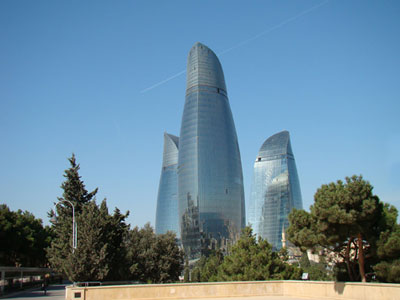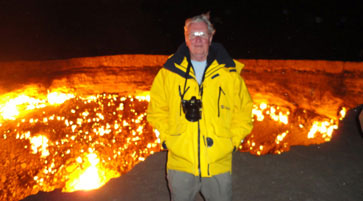‘Caspian Odyssey’ train tour
This item appears on page 26 of the April 2016 issue.
The South Caucasus and Central Asia are not common tourist destinations, even though the area has been traversed by many conquerors and is along the old Silk Road.
Whenever friends of ours heard about the “Caspian Odyssey” tour that we were planning to take there aboard the Golden Eagle, a private luxury train, their first question inevitably was, “Where is that?” The answer required a good map.
Answering their second question — “Is it safe?” — was easy. Yes, it’s perfectly safe.
My longtime companion, Joan, and I booked our trip through MIR Corporation (Seattle, WA; 800/424-7289, www.mircorp.com), a regular advertiser in ITN and one we’ve done business with several times. The tour can also be booked directly with Golden Eagle Luxury Trains (www.goldeneagleluxurytrains.com).
Our booking was for Oct. 16-31, 2014, in a Gold Class cabin. We had traveled on the Golden Eagle before and decided Gold Class was the best compromise between size and cost. Including hotel nights, we paid approximately $25,000 per person, not including airfare.
We booked our air through MIR Corp., as they have an excellent air department very willing to work with travelers. They came up with better prices than I could find, about $1,900 per person from Washington Dulles to Yerevan, Armenia, via Paris (hotel overnight, booked on our own) and from Almaty, Kazakhstan, back to Washington via Amsterdam (hotel overnight, again booked on our own).
We spent the tour’s first night in Yerevan at the Marriott and boarded the train the next night after a day-long city tour.
The train was our “hotel” for most of the trip. Space in our cabin was quite limited. Each train car had two attendants, ensuring that someone was available 24 hours a day.
Not including our Golden Eagle escorts, about 62 people were in our group. Our fellow travelers were mostly British and Australian, but there also were South Africans, a Hong Kong couple and a handful of Germans, South Americans and US nationals. The train staff was almost entirely Russian.
The train moved primarily at night, while our days were dedicated to touring cities or the surrounding countryside.
Flexibility is the key to enjoying this type of tour. Travel by bus in these regions can be time-consuming, and on a number of days we returned to the train later than expected.
Border crossings also were unpredictable and occasionally put us behind schedule. While the vagaries of Customs officials sometimes caught everyone off guard, the issues that did arise were handled smoothly by the experienced Golden Eagle staff.
After leaving Armenia, the train took us through Georgia and on to Baku, Azerbaijan. Direct travel between Armenia and Azerbaijan was not allowed, as the two countries do not have diplomatic relations. In fact, a few staff members of Armenian origin or with Armenian passports had to leave the train in Georgia and fly to Ashgabat, Turkmenistan, our next destination after Baku.
We found Baku to be a thoroughly modern city, a result of its oil wealth. We had the best hotel of the entire trip there, the Four Seasons Hotel (Neftchilar Ave. 77/79, Baku; www.fourseasons.com/baku). We stayed there as the train was transferred by ferry across the Caspian Sea to Turkmenistan.
(A few travelers in our group opted to go on the ferry, which proved to be a mistake. They said the facilities were miserable, overall conditions were dirty and the food was terrible. Golden Eagle crew ended up using train supplies and cooking for them.)
I had never seen a city like Ashgabat before. All buildings were covered in white marble, giving the city a ghostly appearance, especially in the evening. Monuments were huge and dedicated to the country’s leader. We saw few people, and rarely did a car go by, further enhancing the idea of a ghost city. It was pretty in a way but very strange. We stayed in a hotel in Ashgabat as well.
As we headed toward Uzbekistan and Kazakhstan, the terrain turned to desert — barren and flat — and it was much colder. Up to that time, the scenery had been mostly urban and hilly. When we reached Almaty in Kazakhstan, the end of our train journey, there was snow on the ground.
We got off the train in Almaty on Oct. 30, toured the city that day and spent a pleasant night in the Intercontinental Almaty. We were supposed to take a nonstop KLM flight to Amsterdam the next day, however our flight was taken out of service for one day, so we ended up flying out on Nov. 1. Through a combined effort between MIR Corp. and Golden Eagle, all of us were accommodated for an extra night.
All six countries we had traveled through were primarily Muslim, but we never saw a burka on any of the women. In fact, alcohol was served everywhere we went, and in many cities there were casinos. All of these countries are former Soviet republics that are still dictatorships, but they all seemed to have a very liberal view of Islam. One note — you will not wish to see another mosque for some time after this trip.
Throughout our tour, many of the local people we met spoke English, and all were unfailingly friendly, eager to help in any way they could and willing to share their ideas and thoughts with us. They liked discussing prices, and we enjoyed the banter.
The food was excellent everywhere we went.
We recommend this trip to anyone who wants to see a part of the world that is interesting and different.
NYCKLE WIJBRANDUS
East Petersburg, PA


